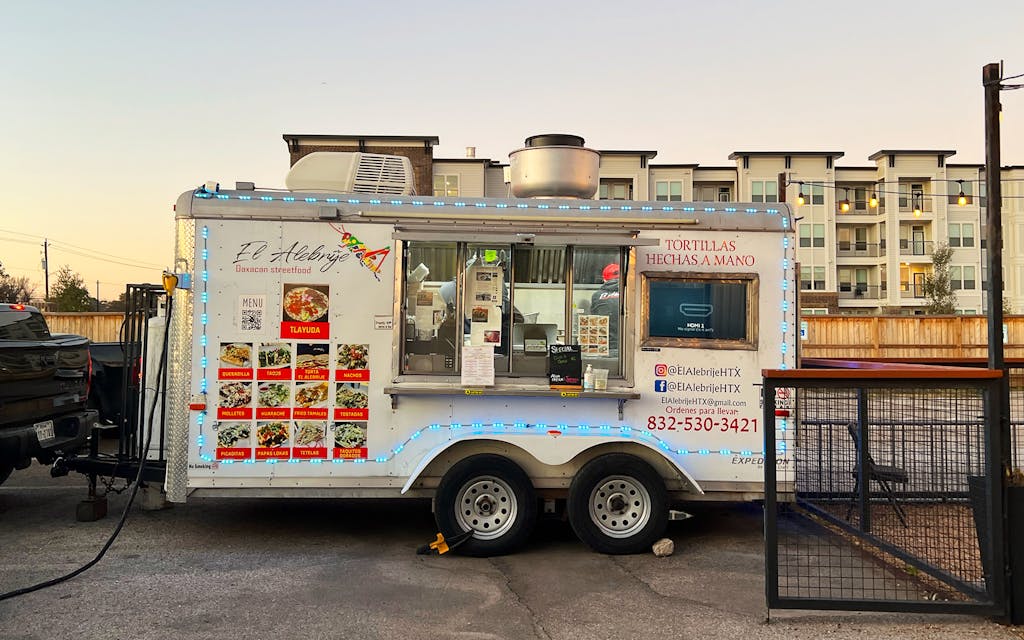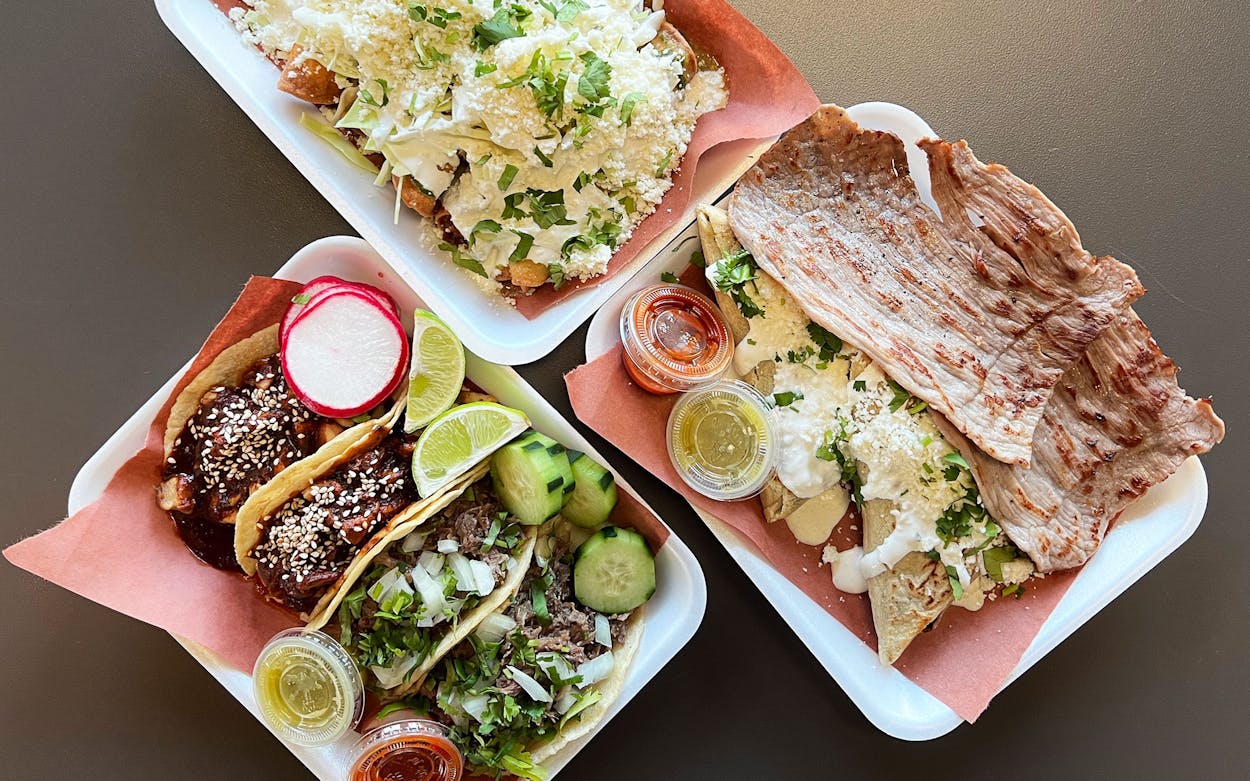In 2020, after fifteen years working in restaurant kitchens, Memo Quintero lost his job. His chef position at a Houston restaurant was eliminated as a result of the pandemic. Meanwhile, his wife, Didi Quintero, was finishing her studies at the University of Houston. Their income was dissipating and they needed to do something.
They started to sell tlayudas—crispy, fourteen-inch corn tortillas slathered with beans, lettuce, tomatoes, quesillo, and more, from Memo’s native Oaxaca—out of their home. “It did well enough that I began to think how we could move into a food truck,” Memo says. The couple borrowed money from family members and opened their small trailer, El Alebrije Oaxacan Streetfood, in April 2021.
To say that year was a memorable one for the Quinteros is an understatement. “I graduated from college, got pregnant, and opened a food truck, all within a year,” Didi says, laughing. “It was a lot.” Their decision to focus on that particular cuisine was risky. “We decided to sell Oaxacan food because we didn’t see anyone else doing it,” Memo says.

Indeed, there is a dearth of restaurants dedicated to Oaxacan cuisine in Texas. In Houston, one of the only other businesses might be Hugo Ortega’s Xochi, which is a modern, fine-dining interpretation. El Naranjo in Austin serves traditional Oaxacan-inspired dishes from James Beard Award-winner Iliana de la Vega. There are at least two Oaxacan trailers, also in Austin, and a joint in Dallas. There might be a smattering of other restaurants, but I have yet to find them.
Oaxacan food is a contradiction—both predominantly unfamiliar and revered. Many Mexicans, culinary experts, and foodies believe Oaxacan cuisine is the pinnacle and soul of Mexican food. It is the most traditional, in that it uses pre-Hispanic ingredients and dishes protected and served by the sixteen Indigenous groups of the state. The two largest groups are the Zapotecs and the Mixtecs. (Memo is Mixtec.) The groups’ isolation in the rugged, mountainous landscape of Oaxaca has allowed them to retain their culture, language, and food. Yet the ingredients—such as edible insects and the herb hoja santa—and the dishes—such as thousands of moles that aren’t brown, non-beef barbacoa, tlayudas, tacos de cazuela, and a variety of tamales that aren’t called “tamal”—can be alienating. I’ve lost count of the number of times well-intentioned people have claimed pipian verde (a pumpkin seed–based green mole) isn’t a mole.
The regional distinction in nomenclature adds to the confusion. El Alebrije’s menu is no exception. What’s listed as “cecina” isn’t the typical dried, spice-slathered rectangles of pork. Rather, the Quinteros serve a beef cecina that is similar to tasajo: thin, dried, and slightly tough beef. The difference is due to geography. Cecina is beef in Memo’s hometown, Venta Uribe de Juárez, approximately four hours northwest of the capital of Oaxaca. “But if someone asks for tasajo, we know they mean our cecina,” Memo says. I ask for cecina to accompany my tetelas, black bean–stuffed masa triangles doused in crema and sprinkled with queso fresco, onions, and cilantro. The cecina has an initial saltiness that gives way to a surprising sweet note, and with a little effort, the meat pulls in wide threads. In Memo’s hometown, tetelas are called memelas (the latter, though, are usually round with crimped edges).
The couple also debated about the names. “I suggested [tasajo] because, like the same thing with [tetelas], Memo wanted to put different names on it because that’s how he knew them,” Didi says. “[Tetela and cecina] are better-known words to people,” Memo says in response.
The mole at El Alebrije isn’t the popular mole negro, instead, it’s a mole rojo available as a taco. During my visit, my taco de mole was served with cubed white-meat chicken. My teeth tingled from the spice. Didi assured me that cubing the meat isn’t the standard El Alebrije method. “We prefer to shred the chicken so that it becomes part of the mole,” she says.
The tlayuda is cracker-thin, smeared with black beans, and loaded with quesillo, tomatoes, and lettuce. You could opt to top it with chorizo, cecina, or chapulines (crunchy, roasted grasshoppers). Chapulines are also available in a taco and as a side, perfect for snacking on like popcorn. “The tlayuda is our most popular dish,” Memo says. “After that it’s the tacos and mole.”
The Quinteros have had to compromise to serve their customers at North Shepherd Brewing. El Alebrije’s barbacoa is a juicy bramble of beef, not because the owners believe diners won’t purchase goat barbacoa, but because they’ve have had trouble finding a reliable source. Huitlacoche and squash blossoms were available as taco fillings early on, but they were quickly removed. “They didn’t sell,” Didi says. “With the whole brewery thing and especially a lot of people not knowing a lot of maybe more authentic Oaxacan food, we kind of had to adjust.” They added nachos and loaded fries. “They’re what people like to eat at breweries and kind of snack on,” Didi says.
Now, after almost three years, the Quinteros are successful enough to be building a bigger trailer. They’re also ready to introduce other regional Oaxacan dishes, including puerco enchilado—dried, cured pork that’s been rubbed with chiles—to the trailer’s menu. “People are coming from far away to try our Oaxacan food,” Didi says. “We want to be able to offer that more authentic Oaxacan food now.”
El Alebrije Oaxacan Streetfood
4816 N. Shepherd Drive, Suite A
Phone: 832-530-3421
Hours: Wednesday–Friday 4–9, Saturday 1–9, Sunday 1–7








